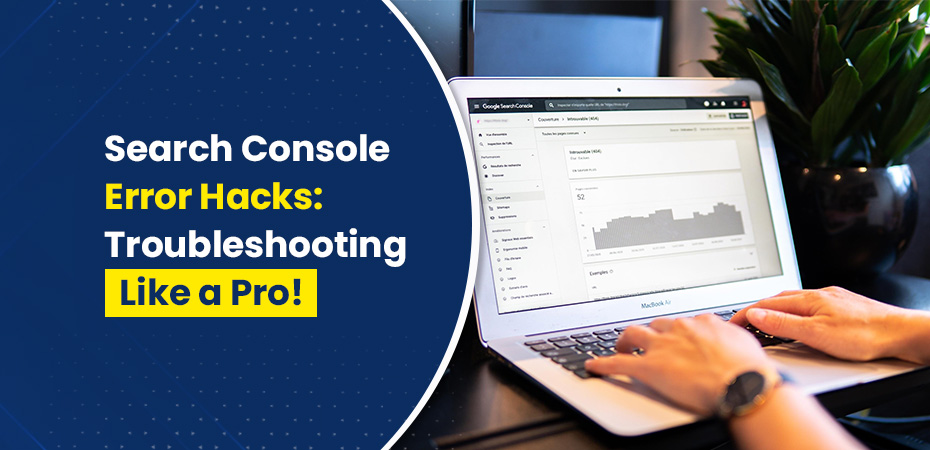Search Console Error Hacks: Troubleshooting Like a Pro



Have you considered why your website may not be performing as expected in Google web search results? The answer might be found in your Google Search Console data.
Using Google Search Console is like using a health monitoring system for your website. It’s a diagnostic tool that helps you identify and fix issues that are affecting your site’s visibility in search results. This free tool from Google provides valuable insights into how search engines interact with your website.
Here’s why Search Console is so important for your website’s success:
- Spotting issues quickly: With real-time error detection, you can find errors before they start hurting your rankings.
- Understanding user behavior: Detailed performance metrics show you how people discover and engage with your content.
- Getting direct feedback from Google: Search Console lets you know about any potential issues that could be impacting your site.
Some common errors encountered on Search Console include:
- Server errors (5xx)
- 404 “Not Found” pages
- Google Indexing issues
- Mobile usability issues
- Security concerns
Are you ready to become an expert at troubleshooting using Search Console? Let’s take a closer look at these specific errors and learn how to fix them like a pro. Your website’s health – and your search rankings – depend on it.
Understanding Google Search Console Errors
Search Console errors are signals that indicate potential issues affecting your website’s performance in Google search results. These errors can range from minor technical hiccups to critical problems that might prevent Google from properly crawling and indexing your content.
The Index Coverage Report: Your Error Detection Hub
The Index Coverage Report serves as your primary diagnostic tool in Search Console. You can request web crawl on Google Search Console with its help. It provides a comprehensive view of:
- Indexed Pages: Successfully crawled and added to Google’s index
- Excluded Pages: Intentionally not indexed due to specific reasons
- Pages with Errors: Content that Google couldn’t properly process
- Valid Pages with Warnings: Issues that need attention but aren’t critical
Common Error Types You’ll Encounter
1. Server Errors (5xx)
These errors indicate problems on the server side that prevent Google from accessing your pages. They include:
- Internal server issues
- Resource limitations
- Configuration problems
- Database connection failures
2. Client Errors (4xx)
Client errors occur when there is an issue with the request made by the client (Googlebot). Common client errors include:
- 404 Not Found: Missing or deleted pages
- 403 Forbidden: Access restrictions
- 401 Unauthorized: Authentication issues
3. Crawl Anomalies
Crawl anomalies are unexpected issues that occur during the crawling process. These can include:
- Timeout errors during page fetching
- DNS resolution problems
- Robot.txt fetch issues
4. Soft 404 Errors
Soft 404 errors happen when a page returns a 200 status code but doesn’t contain any meaningful content. This can occur due to:
- Incorrect redirects
- Empty search results pages
5. Mobile Usability Issues
Mobile usability issues affect how your website appears and functions on mobile devices. Common issues include:
- Text too small to read
- Clickable elements too close together
- Content wider than screen
- Viewport not properly set
Each error type requires a specific approach for resolution. The Index Coverage Report helps prioritize these issues by showing their impact on your site’s visibility. By monitoring these errors regularly, you can maintain a healthy website that Google can efficiently crawl and index.
Identifying Search Console Errors
In this section, we’ll explore the practical steps you can take to identify and diagnose issues in Google Search Console. Follow this guide for effective error detection:
Index Coverage Report: Your First Stop
The Index Coverage Report serves as your diagnostic dashboard. Here’s how to use it effectively:
- Click on “Coverage” in the left-hand menu
- Look for the color-coded status indicators:
- Red: Error
- Yellow: Warning
- Green: Valid
- Filter results by status type to focus on specific issues
- Check the “Details” section for in-depth explanations
Regular Site Audits
Create a systematic approach to site monitoring:
- Set up weekly automated reports
- Create custom alerts for critical errors
- Document patterns in error occurrences
- Track error resolution progress
URL Inspection Tool Deep Dive
The URL Inspection tool reveals granular insights about specific pages:
- Live Test: Check how Google currently sees your page
- Indexed Version: Compare current vs. last crawled version
- Mobile Usability: Identify mobile-specific issues
- Rich Results: Verify structured data implementation
Pro Tip: Use the “Test Live URL” feature to immediately validate fixes without waiting for Google’s next crawl.
Custom Error Detection Strategy
Build a personalized error monitoring system:
- Create a spreadsheet tracking recurring issues
- Set priority levels for different error types
- Document error patterns by page type
- Monitor seasonal traffic fluctuations that might trigger errors
Remember to cross-reference your findings with server logs and analytics data for a complete picture of your site’s health.
Fixing Common Search Console Errors
Here are some practical solutions for the most frequent Search Console errors you might encounter.
Server Errors (5xx)
1. Check Server Logs
- Access your server’s error logs
- Look for patterns in timestamps and error messages
- Identify specific URLs causing issues
2. Resource Management
- Monitor server CPU and memory usage
- Upgrade hosting plan if resources are consistently maxed out
- Implement caching solutions to reduce server load
3. Contact Your Host
- Share error logs with your hosting provider
- Request server configuration review
- Ask about recent server updates or maintenance
Google Error 404
1. Implement 301 Redirects htaccess Redirect 301 /old-page.html /new-page.html
2. Update Internal Links
- Run a site crawl to find broken internal links
- Fix or remove outdated links in your content
- Update navigation menus and sidebars
3. Handle Removed Content
- Create custom 404 pages with helpful navigation
- Restore valuable content that was accidentally removed
- Set up redirects to relevant alternative pages
Quick Fixes for Other Common Issues
- Soft 404s: Add meaningful content to thin pages
- Redirect Chains: Simplify to direct one-to-one redirects
- Mobile Usability: Test and optimize responsive design
- Security Issues: Install SSL certificate and update CMS
Remember to validate your fixes using the URL Inspection tool and monitor the Index Coverage report for improvements.
Preventative Measures for Future Issues
Let’s tackle crawling and non indexed pages on Google Console before they become problems. A proactive approach saves time and maintains your site’s search visibility.
XML Sitemap Best Practices:
- Keep your sitemap under 50MB and 50,000 URLs
- Update your sitemap when adding or removing pages
- Include only canonical URLs
- Set the lastmod tag with accurate timestamps
- Submit your sitemap through Search Console monthly
Optimizing robots.txt:
- Place the file in your root directory
- Use specific directives for different user agents
- Block non-essential pages like admin areas
- Allow access to important CSS and JavaScript files
- Test your robots.txt in Search Console’s testing tool
Additional Prevention Strategies:
- Implement proper URL structures
- Use canonical tags to prevent duplicate content
- Monitor crawl budget with log file analysis
- Set up 301 redirects before removing pages
- Check internal linking structure regularly
Technical Maintenance Tips:
- Run weekly crawl tests
- Monitor server response times
- Check for broken internal links
- Verify mobile responsiveness
- Keep your CMS and plugins updated
These preventative measures create a solid foundation for search engines to crawl and index your site effectively. Regular implementation of these practices helps avoid common technical SEO issues and maintains your site’s visibility in search results.
Regular Maintenance Strategies for a Healthy Website
A healthy website demands consistent attention and proactive maintenance. Let’s dive into essential strategies to keep your site performing at its best.
Performance Audits: Your Website’s Health Check
Regular performance audits serve as your website’s vital signs check. Here’s what to monitor:
Page Load Speed
- Track loading times across different pages
- Identify and compress large media files
- Optimize server response times
Core Web Vitals
- Measure Largest Contentful Paint (LCP)
- Check First Input Delay (FID)
- Monitor Cumulative Layout Shift (CLS)
Mobile Usability Optimization
Your mobile experience can make or break your website’s success. Focus on these key areas:
Responsive Design Testing
- Test across various screen sizes
- Check touch-target sizing
- Verify text readability without zooming
Mobile-First Features
- Implement accelerated mobile pages (AMP)
- Enable mobile-friendly navigation
- Optimize images for mobile devices
Pro Tip: Set up automated monitoring tools to alert you about performance issues before they impact your users. Popular options include:
- Google Analytics Real-Time Monitoring
- GTmetrix Performance Tracking
- Pingdom Website Speed Test
Remember to schedule monthly performance reviews and keep detailed records of any changes made to your site. This practice helps track the impact of your optimization efforts and identifies patterns in performance fluctuations.
Conclusion
Mastering Google Search Console error management transforms your website’s performance from reactive to proactive. A strategic approach to error identification and resolution keeps your site running smoothly, enhances user experience, and maintains strong search engine visibility.
Here’s what makes Web Search Console troubleshooting effective:
- Real-time monitoring catches issues before they impact your site’s performance
- Systematic error resolution prevents recurring problems
- Data-driven insights guide your optimization decisions
Your website’s health directly impacts your online success. Google Search Console provides the tools you need to maintain peak performance. Are you ready to explore website optimization in greater detail? Visit Hire Core Web Vitals Consultants to discover advanced strategies for enhancing your site’s performance and user experience.
Remember: A healthy website is one that continues to grow. Make Search Console monitoring part of your daily digital routine.
Frequently Asked Questions (FAQs)
Check your Search Console at least weekly for critical errors. Set up email notifications for immediate alerts about significant issues.
Yes, unresolved errors can impact your site’s visibility in search results and user experience, potentially leading to lower rankings.
A regular 404 error occurs when a page doesn’t exist. A soft 404 happens when a page returns a 200 status code but contains no meaningful content.
Prioritize critical errors like server issues (5xx) and security problems first. Less critical issues like minor crawl errors can be addressed systematically over time.
Document the issue and consult with your web developer or hosting provider. Some technical errors require expert assistance to resolve properly.